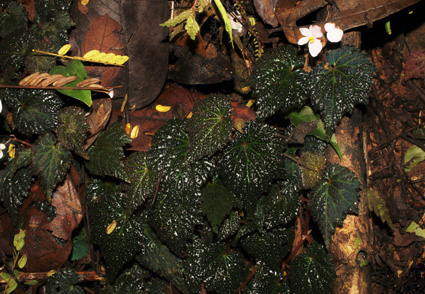Abstract
Begonia tinuyopensis is described and illustrated as a new species from Zamboanga del Norte, Philippines. This new species resembles B. mearnsii by having a decumbent stem, scattered hairs over the entire plant, terminal inflorescence bearing 2 staminate tepals and 5 pistillate tepals. However, Begonia tinuyopensis is distinct by having sparse pilose (vs. matted with long brown hairs) stems, ovate (vs. suborbicular to subreniform) leaves and glabrous (vs. densely pubescent) ovary. We assign B. tinuyopensis as Endangered (EN) following IUCN Red List Criteria.
References
Ang, Y.P., Tandang, D.N., Agcaoili, J.M.M. & Bustamante, R.A.A. (2020b) Begonia cabanillasii (section Baryandra, Begoniaceae), a new species from El Nido, Palawan, the Philippines. Phytotaxa 453 (3): 244–254. https://doi.org/10.11646/phytotaxa.453.3.6
Bachman, S., Moat, J., Hill, A.W., de la Torre, J. & Scott, B. (2011) Supporting Red List threat assessments with GeoCAT: geospatial conservation assessment tool. In: Smith, V. & Penev, L. (Eds.) e-Infrastructures for data publishing in biodiversity science. ZooKeys 150: 117–126. (Version BETA). https://doi.org/10.3897/zookeys.150.2109
Blume, C.L. (1825) Spathoglottis plicata. In: Bijdragen tot de flora van Nederlandsch Indie. pp. 401. https://doi.org/10.5962/bhl.title.395
Buenavista, P.D., Ang, Y.P., Pranada, M.A.K., Salas, D.S., Mollee, E. & Mcdonald, M. (2021) Begonia bangsamoro (Begoniaceae, section Petermannia), a new species from Mindanao Island, the Philippines. Phytotaxa 497 (1): 39–48. https://doi.org/10.11646/phytotaxa.497.1.4
Bustamante, R.A.A., Tandang, D.N., Pranada, M.A.K. & Ang, Y.P. (2020) Begonia truncatifolia (Begoniaceae, section Baryandra), a new species from Palawan Island, the Philippines. Phytotaxa 458 (3): 215–222. https://doi.org/10.11646/phytotaxa.458.3.4
de Candolle, A. (1859) Mémoire Sur La Famille Des Bégoniacées. Annales des Sciences Naturelles; Botanique 11: 122–134. Available from: https://www.biodiversitylibrary.org/item/129892 (accessed 26 May 2021)
Hughes, M. & Coyle, C. (2009) Begonia section Petermannia (Begoniaceae) on Palawan (Philippines), including two new species. Edinburgh Journal of Botany 66: 205–211. https://doi.org/10.1017/S0960428609005307
Hughes, M., Moonlight, P., Jara, A., Tebbitt, M., Wilson, H. & Pullan, M. (2015 onwards) Begonia Resource Centre Royal Botanic Garden Edinburgh. Available from: https://padme.rbge.org.uk/begonia (accessed 22 March 2021)
IUCN Standards and Petitions Committee (2019) guidelines for Using the IUCN Red list Categories and Criteria. Version 14. Prepared by the Standards and Petitions Committee. Available from: http://www.iucnredlist.org/documents/RedListGuidelines.pdf (accessed 10 March 2021)
Klotzsch, J.F. (1854) Begoniaceen-Gattungen und Arten. Abhandlungen der Königlichen Akademie der Wissenschaften zu Berlin 194– 243. Available from: https://www.biodiversitylibrary.org/item/92694 (accessed 29 May 2021)
Lin, C.-W., Chung, S.-W. & Peng, C.-I (2014) Three new species of Begonia (sect. Petermannia, Begoniaceae) from Sarawak, Borneo. Phytotaxa 191 (1): 129–140. https://doi.org/10.11646/phytotaxa.191.1.8
Liu, S.-H., Tseng, Y.-H., Zure, D., Rubite, R.R., Balongcod, T.D., Peng, C.-I. & Chung, K.-F. (2019) Begonia balangcodiae sp. nov. from northern Luzon, the Philippines and its natural hybrid with B. crispipila, B. × kapangan nothosp. nov. Phytotaxa 407 (1): 5–21. https://doi.org/10.11646/phytotaxa.407.1.3
Linnaeus, C. (1753) Species Plantarum: exhibentes plantas rite cognitas ad genera relatas, cum diferentiis specificis, nominibus trivialibus, synonymis selectis, locis natalibus, secundum systema sexuale digestas. Vol. 1. Berlin. pp. 320. https://doi.org/10.5962/bhl.title.59734
Linnaeus, C. (1753) Species Plantarum. Vol. 2. Laurentius Salvius, Stockholm, pp. 561–1200.
Merrill, E.D. (1908) New or noteworthy Philippine plants VI. The Philippine Journal of Science 3C: 220.
Merrill, E.D. (1911) The Philippine species of Begonia. The Philippine Journal of Science, section C, Botany 6 (6): 369–399. Available from: https://www.biodiversitylibrary.org/item/1116. (accessed 4 April 2021)
Merrill, E.D. (1912) Begoniaceae. The Philippine Journal of Science, section C, Botany 7 (6): 308–312. Available from: https://www.biodiversitylibrary.org/item/1117 (accessed 4 April 2021)
Merrill, ED. (1922) New or noteworthy Philippine plants XVII. The Philippine Journal of Science 20: 407.
Merrill, E.D. (1925) Additions to our knowledge of Philippine flora, I. The Philippine Journal of Science 26 (4): 478–479. Available from: http://name.umdl.umich.edu/act3868.0026.001. (accessed 4 April 2021)
Moonlight, P.W., Ardi, W.H., Padilla, L.A., Chung, K.-F., Fuller, D., Girmansyah, D., Hollands, R., Jara-Muñoz, A., Kiew, R., Leong,W.C., Liu, Y., Mahardika, A., Marasinghe, L.D.K., O’Connor, M., Peng, C.-I., Pérez, Á.J., Phutthai, T., Pullan, M., Rajbhandary, S., Reynel, C., Rubite, R.R., Julia, S., Scherberich, D., Shui, Y.-M., Tebbitt, M.C., Thomas, D.C., Wilson, H.P., Zaini, N.H. & Hughes, M. (2018) Dividing and conquering the fastest-growing genus: Towards a natural sectional classification of the mega-diverse genus Begonia (Begoniaceae). Taxon 67 (2): 267–323. https://doi.org/10.12705/672.3
Rule, M.G.Q., Ang, Y.P., Rubite, R.R., Docot, R.V.A., Bustamante, R.A.A., Robinson, A.S. (2020) Begonia makuruyot (Begoniaceae, section Baryandra), a new species from Surigao del Norte Province, Philippines. Phytotaxa 470 (3): 226–234. https://doi.org/10.11646/phytotaxa.470.3.2
Pelser, P.B., Barcelona, J.F. & Nickrent, D.L. (Eds.) (2011 onwards) Co’s Digital Flora of the Philippines. Available from: www.philippineplants.org (accessed 6 January 2021)
Peng, C.-I, Rubite, R.R. & Lin, C.-W. (2017) Begonia polyclada (sect. Petermannia, Begoniaceae), a gracile new species from Luzon, Philippines. Phytotaxa 296 (1): 93–97. https://doi.org/10.11646/phytotaxa.296.1.8
Reinwardt, C. (1851) Nederlandsch Kruidkundig Archief. Verslangen en Mededelingen der Nederlandsche Botanische Vereeniging 2 (2): 118–119.
Rubite, R.R. (2013) Begonia section Petermannia of Luzon Island, The Philippines. Philippine Journal of Science 142: 183–197.
Tebbitt, M.C. (2005) Begonias: cultivation, identification and natural history. Timber Press, Portland, 336 pp.


